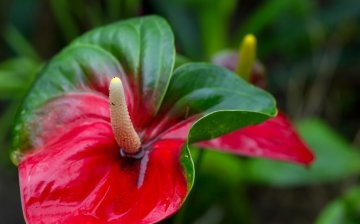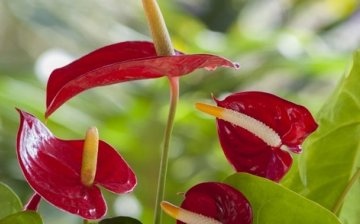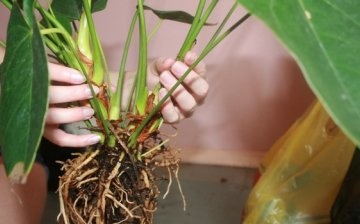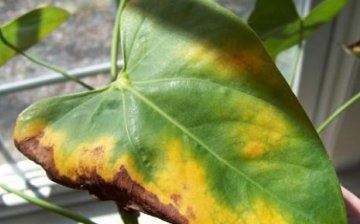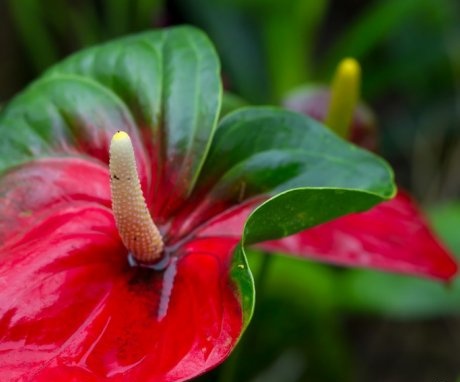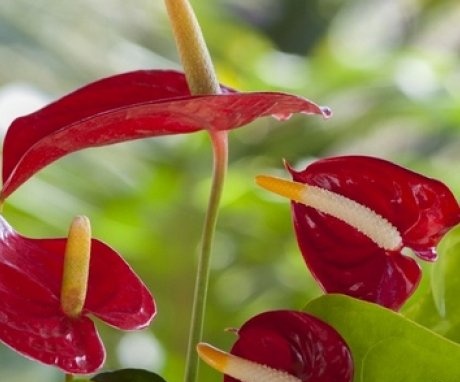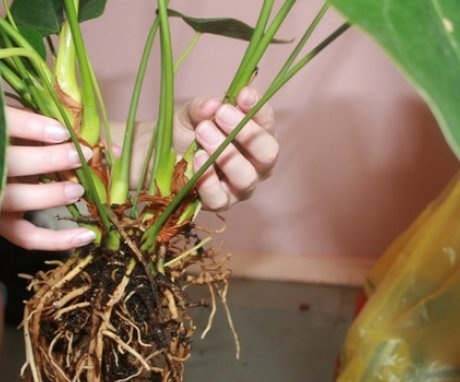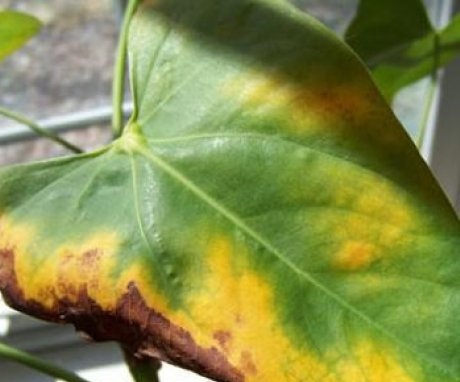Floriculture: how to properly care for anthurium at home
Anthurium considered a capricious plant. It is quite difficult to achieve its luxurious flowering at home, but it is possible. The florist will need to create certain conditions, without which the cultivation of anthurium is very problematic.
Providing the plant with sufficient moisture and warmth, it will delight with large and exquisite cob flowers. Its dark green, waxy foliage will brighten up any space. Visitors, seeing this tropical wonder, will not be able to take their eyes off it. For the sake of unusual flowering and stunning beauty of foliage, it is worth trying to grow one of the most amazing flowers - anthurium.
Content:
Description of anthurium and its types
The plant belongs to the Aroid family and has about 850 species. It grows wild in Mexico, Brazil, Paraguay, Argentina and the Antilles. These are always tropical and subtropical forests. Anthurium is an epiphytic or semi-epiphytic plant that also grows in the form of a liana, a terrestrial herb. The leaves of the plant have a wide variety of shapes, sizes and colors. These can be large leaves with silvery veins against a background of dark greenery, or they can be small, heart-shaped in a bright green hue. Anthurium foliage is shiny, it looks like the leaves are covered with wax.
The flowers of the plant resemble an ear, which also has different shapes and sizes depending on the type of plant.
The ear is adorned with an inflorescence leaf or bedspread, which can have a variety of shades - white, scarlet, orange, blue, black, yellow-green. Anthurium - This is a flowering plant that many tend to grow at home. But given the birthplace of the flower, this is not easy to do.
For growing at home, only a few types of anthurium are used:
- Andre
- Scherzer
- Majestic
These species have adapted well to the conditions of the apartment. The most "unpretentious" is Scherzer's anthurium, followed by Andre and in last place the Majestic. The Majestic species differs from its counterparts of unearthly beauty with leaves. They are very large, dark green, and silvery streaks scatter against the background of green, like lightning in a black sky. The spectacle is stunning, one gets the impression of a foreign origin of the plant.
In addition to the most common types, there are many others, no less interesting. But they are already grown in heated greenhouses, since they will not be able to develop normally at home. It is customary to cultivate anthuriums not only for beauty, but also for cutting. Flowers stand in bouquets for a long time - up to 4 weeks. Therefore, anthurium has become the most popular plant in the Aroid family.
Growing conditions
For the successful cultivation of anthurium, it is necessary to create certain conditions for it that coincide as much as possible with those in which it grows wild. In other words, it is high humidity, diffused light and a certain soil mixture. Let's consider each point in more detail:
- Humidity. High humidity is a necessary and most important condition for keeping anthurium.Without observing moisture standards, the plant will stop growing and, in the end, die. It is difficult to achieve 85-90% in an apartment, especially in winter. For this, many growers purchase a humidifier. There are other options that are less expensive. The pot with anthurium is covered with sphagnum, which is constantly moistened. Expanded clay can be put in the pallet, which must also always be wet. Many people spray the plant every day, but as experience has shown, this is not a way out, since sprinkling requires certain conditions that few people observe. As a result, the anthurium begins to hurt. The best way out is a humidifier or creating a mini-greenhouse at home. If it is not possible to install special equipment, resort to the little tricks in the care, which will be discussed below.
- Temperature conditions. The second important condition for growing a plant is temperature. In summer, it is maintained between 20 ° and 25 °. In winter, it should not fall below 18 ° -19 °. Do not be frivolous about the temperature of the content of anthurium. If the indicator does not meet the standards, the plant will begin to ache and acquire an untidy appearance. Scherzer's view requires winter rest. To do this, for a couple of months, the temperature must be lowered to 13 ° -16 °. After hibernation, the plant is awakened by raising the temperature to 20 °. Otherwise, its requirements are the same as for all species.
- Soil mixture. The soil for anthurium should be loose, coarsely fibrous. Do not forget that this is an epiphyte, it requires air and moisture permeable soil. Ordinary garden land is not suitable. The best option would be to prepare the soil mixture yourself. This is easy to do. Composition for anthurium: deciduous soil, rough, not sifted (2 parts), marsh moss (1 part), turf soil (1 part) and add some pine bark (2x5 cm pieces). The last component is optional, but desirable. Bone meal is also added to the composition. The result should be a coarse fibrous soil mixture that is good for air and moisture. It is worth noting that purchased mixtures do not have sufficient looseness. Therefore, it is better to make the earth yourself.
- Lighting. Some anthuriums, such as the Majestic View, can grow in partial shade. But most colors prefer diffused sunlight. The plant does not tolerate direct rays. Therefore, it is better to put the pot with anthurium in the east, south or southwest direction. If the plant is on the south side, move it away from the window so that direct sunlight does not fall on it. Lighting should be diffused. The north window is not suitable for anthurium. From a lack of light, the plant begins to curl and turn yellow.
If all conditions of detention are maintained, anthurium will delight with lush flowering all year round, it will not be sick and capricious.
Anthurium care
If the florist has tried and provided the plant with the necessary conditions for keeping, leaving will not present any difficulties:
- The flower loves moisture and therefore needs to be watered often, but without fanaticism. The soil should not be too wet or waterlogged. Water the anthurium every 3-4 days in summer, less often in winter.
- The sprinkling procedure should be carried out only at a temperature not lower than 22 ° -25 °, during the period flowering it is better to refuse it and just wipe the leaves with a damp cloth. To ensure high humidity, it is better to choose one method - a humidifier, wet sphagnum, expanded clay at the bottom of the pallet, sprinkling or wiping the leaves with a damp cloth. You should not use all the methods of moisturizing at once, it will be overkill. The method of wiping the leaves with a damp cloth has proven itself well. This, as experience has shown, is enough.
- After transplants anthurium begins to feed after a month. Use fertilizers for flowering plants - mineral and organic... Top dressing is carried out once every two to three weeks, depending on the condition of the soil and plant. In winter, feeding is reduced to once every two months.
- Young plants are replanted every year as they grow. root system... Adults need a transplant every four years.
- Anthurium is propagated using dividing the bush when transplanting an adult plant. Avoid drafts when keeping anthurium. They have a detrimental effect on the plant, it can die.
It is easy to care for a tropical handsome man if he was provided with all the conditions for growth and development. The main thing is to maintain the desired humidity and air temperature.
Diseases and pests
Of the pests of anthurium, several of the most dangerous can be distinguished - aphids, spider mites and scale insects. At the first sign of the appearance of these parasites, you need to treat the plant with insecticides. If a shield appears, it must be carefully removed with a cotton pad moistened with alcohol. Then treat the plant with an insecticide. If the pests are not removed, the use of drugs will be useless. The scabbard has a shell that protects it from poisons.
Of the diseases, root and stem rot is the most dangerous.
Diseases appear when the soil is waterlogged. If the conditions of detention are not maintained, problems such as curling of leaves, their drying out, anthracnose, yellowing of greenery, and growth retardation may appear. If the plant is damaged by rot or anthracnose, the flower should be treated fungicides, processing is carried out several times. In some cases, neglected, it is more expedient to plant transplant.
Fighting disease is very difficult. Therefore, it is better to follow the rules of care and maintenance. In this case, no pests and diseases will appear. The plant will develop normally and delight with beautiful, large cobs, drowning in lush bedspreads.
More information can be found in the video:




